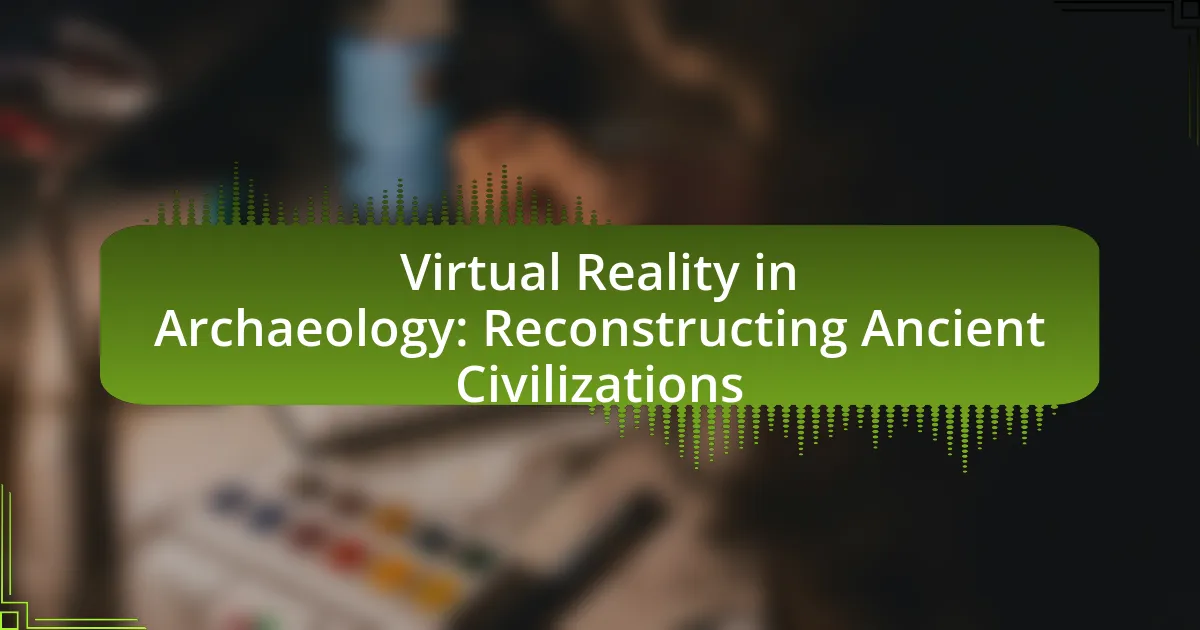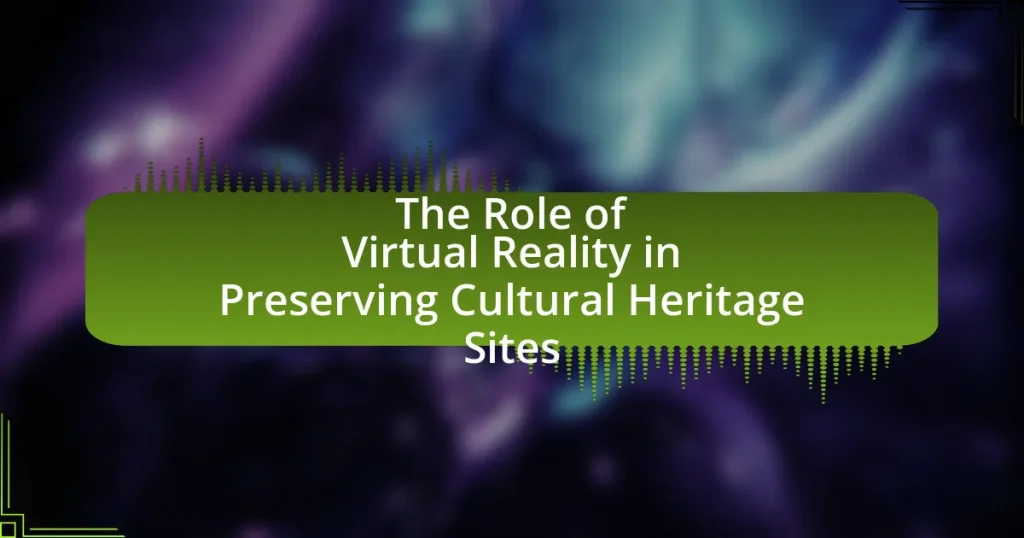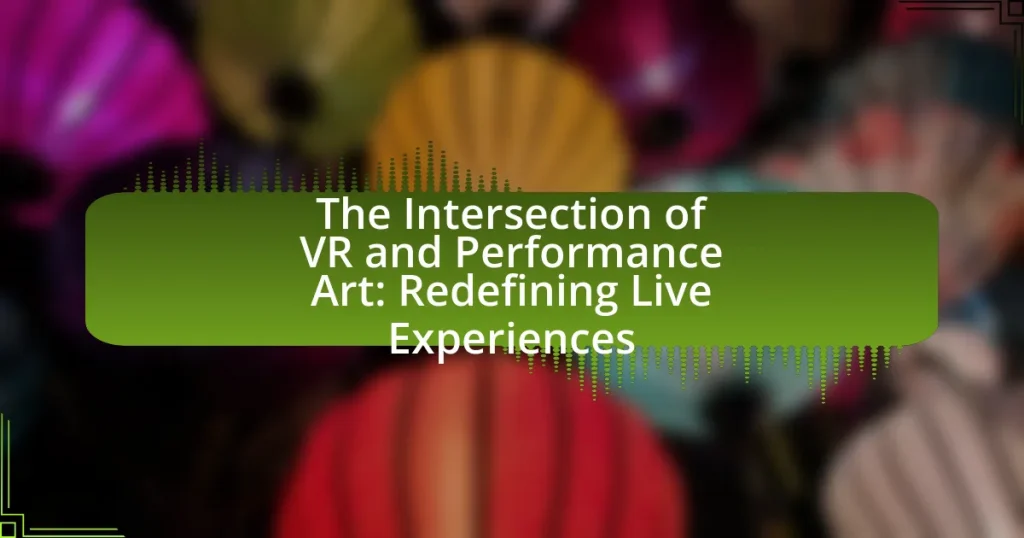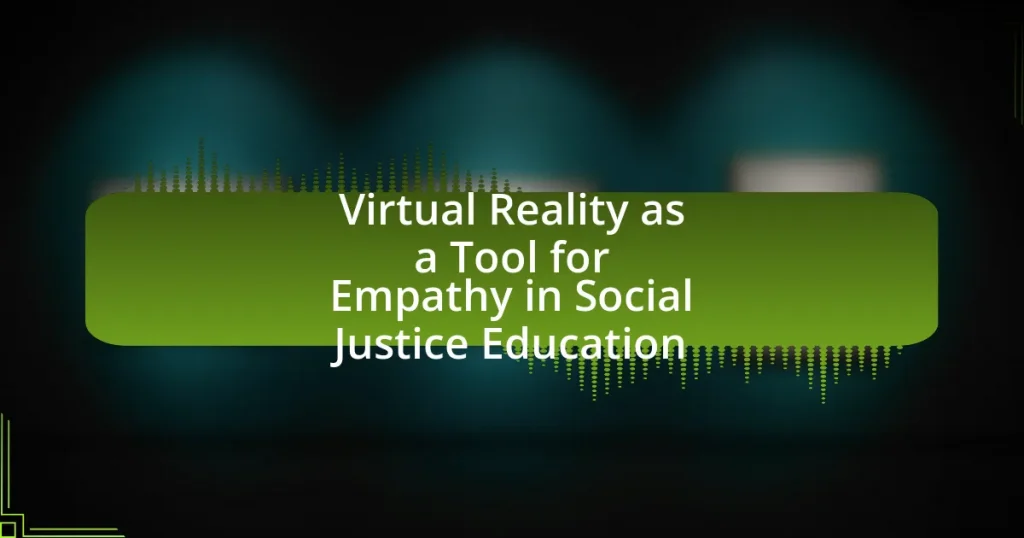Virtual Reality (VR) in archaeology is a transformative technology that enables the reconstruction and immersive exploration of ancient sites and artifacts, enhancing the understanding of historical contexts and cultural heritage. This article examines how VR is utilized in archaeological research, detailing the technologies involved, such as 3D modeling and Geographic Information Systems (GIS), and the advantages it offers over traditional methods. It also addresses the challenges faced by archaeologists, including technical limitations and ethical considerations, while highlighting the future prospects of VR in preserving cultural heritage and improving public engagement with archaeology. Through interdisciplinary collaboration and emerging technologies, VR is poised to revolutionize the study and appreciation of ancient civilizations.
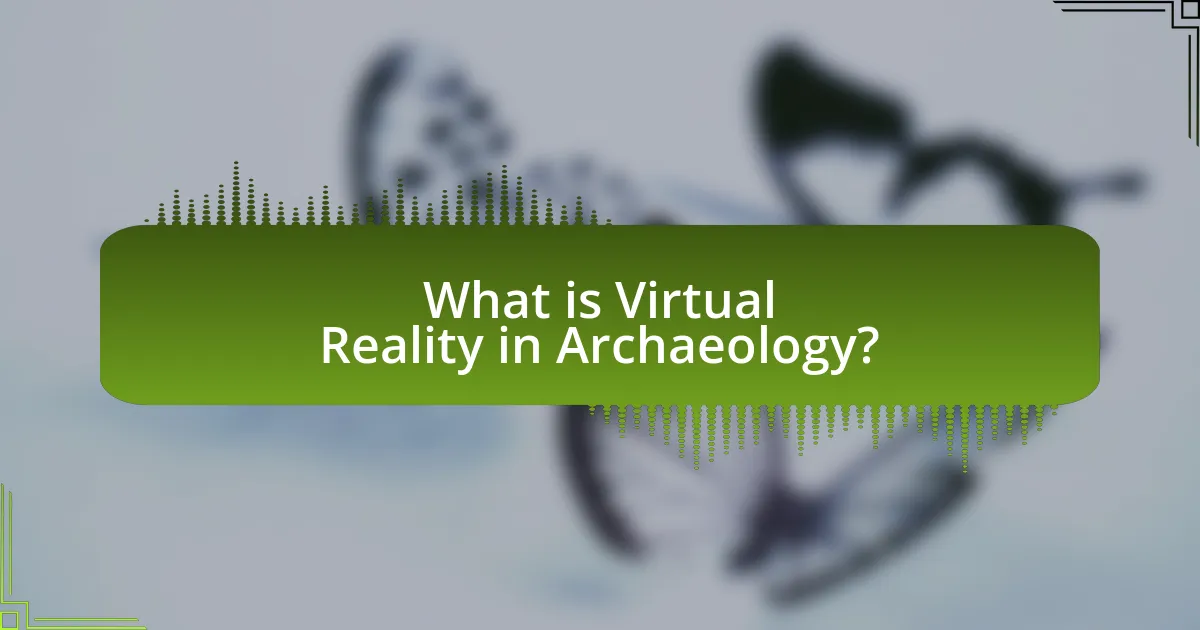
What is Virtual Reality in Archaeology?
Virtual Reality in archaeology is a technology that allows researchers and the public to experience and interact with reconstructed ancient sites and artifacts in a simulated environment. This immersive approach enhances understanding of historical contexts and cultural heritage by providing visual and spatial representations of archaeological findings. For instance, projects like the Virtual Reality reconstruction of Pompeii enable users to explore the city as it appeared before the eruption of Mount Vesuvius, offering insights into daily life and urban planning in ancient Rome. Such applications demonstrate the effectiveness of Virtual Reality in making archaeological research accessible and engaging, thereby fostering a deeper appreciation for ancient civilizations.
How is Virtual Reality utilized in archaeological research?
Virtual Reality (VR) is utilized in archaeological research to create immersive simulations of ancient sites and artifacts, allowing researchers and the public to explore and interact with reconstructed environments. This technology enables archaeologists to visualize spatial relationships and contextualize findings in a way that traditional methods cannot. For instance, VR has been used to reconstruct the ancient city of Pompeii, providing insights into urban planning and daily life during the Roman Empire. Studies have shown that VR can enhance understanding and engagement, making complex archaeological data more accessible and comprehensible to both scholars and the general public.
What technologies are involved in creating virtual archaeological environments?
Creating virtual archaeological environments involves technologies such as 3D modeling software, Geographic Information Systems (GIS), virtual reality (VR) platforms, and photogrammetry. 3D modeling software enables the detailed reconstruction of artifacts and sites, while GIS allows for the integration of spatial data to visualize archaeological contexts. VR platforms provide immersive experiences, allowing users to explore reconstructed environments interactively. Photogrammetry captures real-world objects and sites through photographs, converting them into 3D models, which enhances the accuracy of virtual reconstructions. These technologies collectively facilitate the preservation and exploration of ancient civilizations in a digital format.
How does Virtual Reality enhance the study of ancient civilizations?
Virtual Reality enhances the study of ancient civilizations by providing immersive experiences that allow researchers and students to explore reconstructed environments and artifacts in a highly interactive manner. This technology enables the visualization of historical sites and cultural practices that are otherwise inaccessible or lost, facilitating a deeper understanding of ancient societies. For instance, projects like the Virtual Reality reconstruction of Pompeii allow users to navigate the city as it appeared before the eruption of Mount Vesuvius, offering insights into urban planning, architecture, and daily life in ancient Rome. Such immersive simulations can improve retention of information and engagement, making the study of history more dynamic and impactful.
Why is Virtual Reality important for archaeology?
Virtual Reality is important for archaeology because it allows researchers to create immersive reconstructions of ancient sites, enhancing the understanding of historical contexts. By utilizing VR technology, archaeologists can visualize and interact with 3D models of artifacts and structures, which aids in the analysis and interpretation of archaeological data. For instance, a study by the University of California, Berkeley, demonstrated that VR can simulate the experience of walking through ancient Roman ruins, providing insights that traditional methods cannot offer. This capability not only facilitates education and public engagement but also preserves fragile sites digitally, ensuring that future generations can explore and learn from them without physical degradation.
What advantages does Virtual Reality offer over traditional archaeological methods?
Virtual Reality offers significant advantages over traditional archaeological methods by enabling immersive exploration and visualization of archaeological sites without physical excavation. This technology allows researchers to recreate and interact with ancient environments, facilitating a deeper understanding of historical contexts and spatial relationships. For instance, a study by the University of California, Berkeley, demonstrated that VR can simulate the experience of walking through ancient ruins, providing insights that traditional methods may overlook. Additionally, VR reduces the risk of damaging fragile sites during exploration, preserving them for future study and public engagement.
How does Virtual Reality facilitate public engagement with archaeology?
Virtual Reality (VR) facilitates public engagement with archaeology by providing immersive experiences that allow users to explore and interact with reconstructed ancient sites. This technology enables individuals to visualize historical contexts and artifacts in a three-dimensional space, enhancing their understanding and appreciation of archaeological findings. For instance, projects like the Virtual Reality reconstruction of Pompeii allow users to navigate the ancient city as it appeared before the eruption of Mount Vesuvius, making the historical narrative more tangible and engaging. Studies have shown that such immersive experiences can significantly increase interest in archaeology and cultural heritage, as they create a more personal connection to the past.
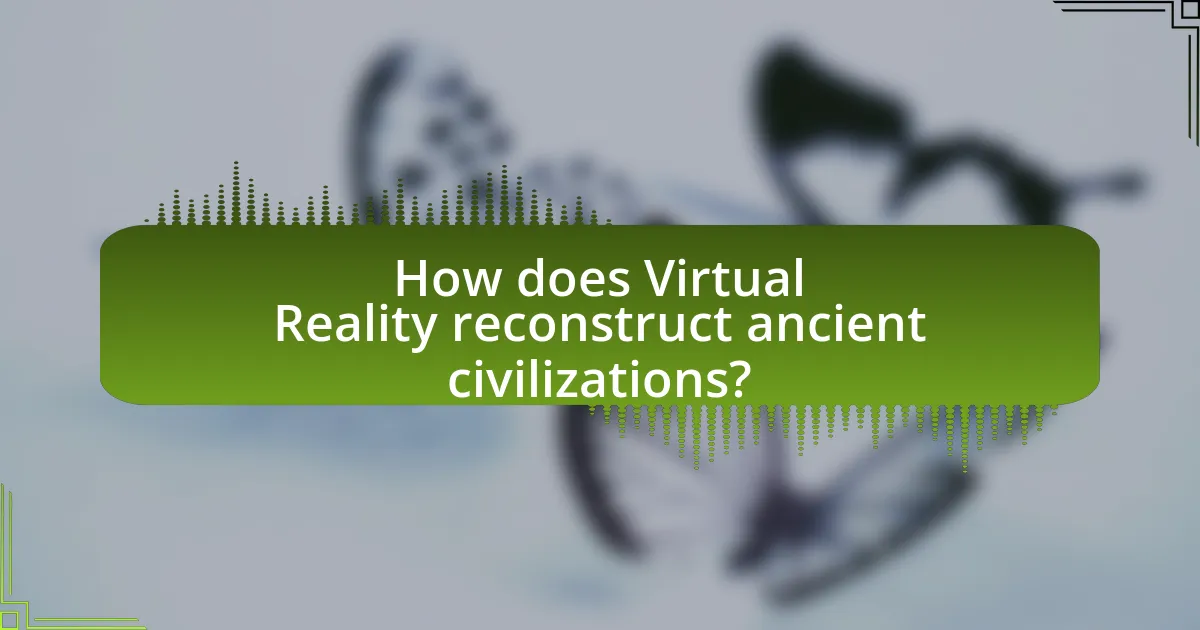
How does Virtual Reality reconstruct ancient civilizations?
Virtual Reality reconstructs ancient civilizations by creating immersive, interactive environments that simulate historical sites and cultural contexts. This technology utilizes data from archaeological findings, historical texts, and 3D modeling to accurately depict structures, artifacts, and daily life in ancient societies. For instance, projects like the Virtual Reality reconstruction of Pompeii allow users to explore the city as it appeared before the eruption of Mount Vesuvius, providing insights into urban planning and social dynamics. Such reconstructions are supported by extensive research, including archaeological surveys and historical documentation, ensuring that the representations are both accurate and educational.
What processes are involved in the reconstruction of ancient sites using Virtual Reality?
The processes involved in the reconstruction of ancient sites using Virtual Reality include data collection, 3D modeling, and immersive visualization. Data collection involves gathering archaeological evidence, such as artifacts, site measurements, and historical texts, which provide the foundational information necessary for accurate reconstructions. 3D modeling utilizes software to create detailed digital representations of the site based on the collected data, allowing for the simulation of structures, landscapes, and environments as they would have appeared in the past. Immersive visualization enables users to experience these reconstructions interactively, often through VR headsets, facilitating a deeper understanding of ancient civilizations. These processes are validated by numerous archaeological projects that have successfully employed VR technology to recreate sites like Pompeii and ancient Rome, demonstrating its effectiveness in enhancing historical interpretation and public engagement.
How do archaeologists gather data for Virtual Reality reconstructions?
Archaeologists gather data for Virtual Reality reconstructions primarily through a combination of field surveys, excavation, and advanced imaging technologies. Field surveys involve systematically examining landscapes to identify archaeological sites, while excavation allows for the collection of artifacts and contextual information. Advanced imaging technologies, such as LiDAR (Light Detection and Ranging) and photogrammetry, enable the creation of detailed 3D models of sites and artifacts. These methods provide accurate spatial data and visual representations, which are essential for creating immersive Virtual Reality experiences that reflect the historical context of ancient civilizations.
What role do 3D modeling and simulations play in this process?
3D modeling and simulations are crucial in the process of reconstructing ancient civilizations through virtual reality in archaeology. They enable researchers to create accurate, interactive representations of historical sites and artifacts, facilitating a deeper understanding of ancient cultures. For instance, 3D models can be generated from archaeological data, allowing for the visualization of structures that no longer exist, such as the ancient city of Pompeii, where simulations help illustrate urban layouts and daily life. This technology enhances educational outreach and public engagement by providing immersive experiences that traditional methods cannot offer, thereby making archaeological findings more accessible and comprehensible to a wider audience.
What challenges do archaeologists face when using Virtual Reality?
Archaeologists face several challenges when using Virtual Reality (VR), including high costs, technical limitations, and the need for specialized skills. The financial investment required for VR technology, software, and hardware can be prohibitive, especially for smaller archaeological projects. Additionally, the technical limitations of VR systems, such as resolution and processing power, can hinder the accurate representation of archaeological sites. Furthermore, archaeologists often require training in VR software and hardware, which can be a barrier to effective implementation. These challenges can impede the widespread adoption of VR in archaeological research and education.
How do technological limitations impact Virtual Reality reconstructions?
Technological limitations significantly impact Virtual Reality (VR) reconstructions by restricting the fidelity and interactivity of the virtual environments. For instance, limitations in processing power can lead to lower graphical quality, resulting in less realistic representations of ancient civilizations. Additionally, constraints in motion tracking technology can hinder user immersion, as inaccuracies may disrupt the experience of navigating through reconstructed spaces. Furthermore, the availability of high-resolution data is crucial; without it, reconstructions may lack detail, making it difficult for users to engage meaningfully with the historical context. These factors collectively diminish the educational and experiential value of VR applications in archaeology, as evidenced by studies showing that higher fidelity environments enhance user engagement and learning outcomes.
What ethical considerations arise in the use of Virtual Reality in archaeology?
The ethical considerations in the use of Virtual Reality (VR) in archaeology include issues of cultural representation, consent, and the potential for misinterpretation of archaeological data. Cultural representation is critical, as VR can risk oversimplifying or misrepresenting the beliefs and practices of ancient civilizations, leading to a distorted understanding of their cultures. Consent is another major concern; the use of VR to recreate sites or artifacts raises questions about the rights of descendant communities and whether they have been adequately consulted or involved in the process. Additionally, the potential for misinterpretation arises when VR experiences are based on incomplete or biased archaeological data, which can perpetuate inaccuracies in public understanding of history. These ethical considerations highlight the need for careful and respectful engagement with both the archaeological record and the communities connected to it.
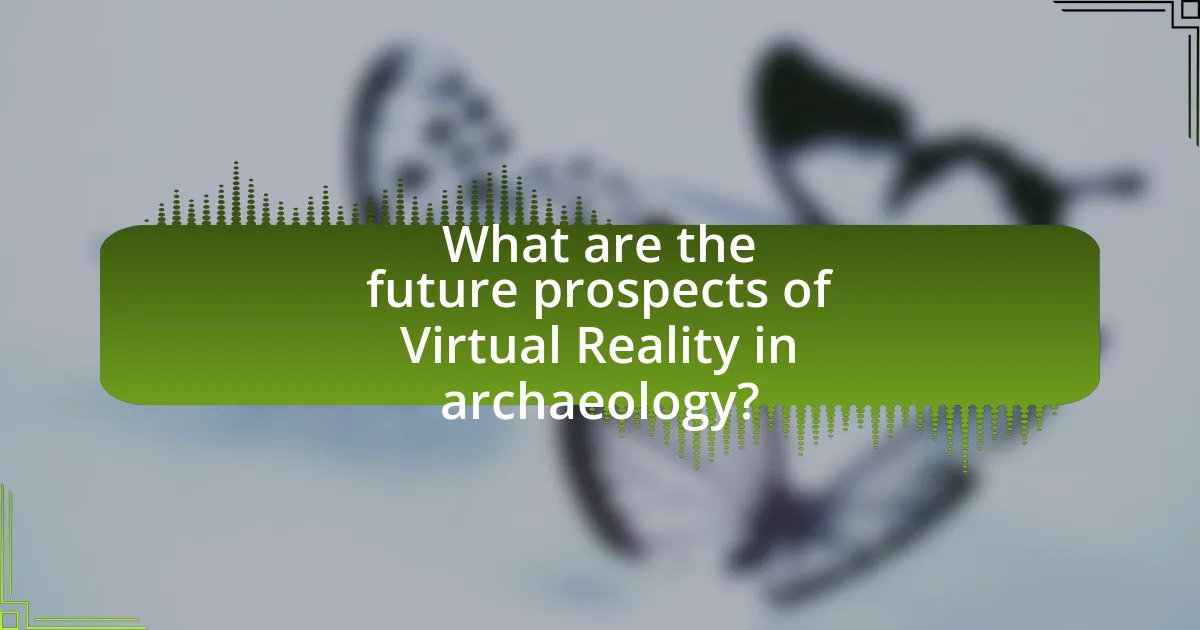
What are the future prospects of Virtual Reality in archaeology?
The future prospects of Virtual Reality in archaeology are highly promising, as it enables immersive experiences that enhance the understanding of ancient civilizations. Virtual Reality technology allows archaeologists to create detailed reconstructions of historical sites, facilitating virtual exploration and analysis without physical excavation. For instance, projects like the Virtual Reality reconstruction of Pompeii have demonstrated how VR can provide insights into urban planning and daily life in ancient Rome. Furthermore, advancements in VR hardware and software are expected to improve accessibility and interactivity, making it easier for researchers and the public to engage with archaeological findings. As a result, the integration of Virtual Reality in archaeology is likely to revolutionize educational approaches, public outreach, and research methodologies in the field.
How might advancements in technology influence archaeological practices?
Advancements in technology significantly influence archaeological practices by enhancing data collection, analysis, and visualization methods. For instance, the use of Geographic Information Systems (GIS) allows archaeologists to map and analyze spatial relationships of artifacts and sites with precision, leading to more informed interpretations of historical contexts. Additionally, technologies such as LiDAR (Light Detection and Ranging) enable the detection of hidden structures beneath dense vegetation, as demonstrated in the discovery of ancient Mayan cities in Central America. Furthermore, virtual reality (VR) applications facilitate immersive reconstructions of archaeological sites, allowing researchers and the public to experience ancient civilizations interactively, which enhances educational outreach and engagement. These technological advancements collectively improve the efficiency and effectiveness of archaeological research, leading to richer insights into human history.
What emerging technologies could enhance Virtual Reality applications in archaeology?
Emerging technologies that could enhance Virtual Reality applications in archaeology include artificial intelligence, photogrammetry, and haptic feedback systems. Artificial intelligence can analyze vast datasets from archaeological sites, enabling more accurate reconstructions and predictive modeling of ancient environments. Photogrammetry allows for the creation of detailed 3D models from photographs, which can be integrated into VR environments to provide immersive experiences of historical sites. Haptic feedback systems enhance user interaction by simulating touch and movement, making virtual explorations more realistic. These technologies collectively improve the accuracy, engagement, and educational value of virtual archaeological experiences.
How can Virtual Reality contribute to the preservation of cultural heritage?
Virtual Reality (VR) can significantly contribute to the preservation of cultural heritage by enabling immersive experiences that allow users to explore and interact with reconstructed historical sites and artifacts. This technology facilitates the documentation and visualization of cultural heritage, making it accessible to a broader audience while preserving the original context and details of these sites. For instance, VR applications have been used to recreate ancient structures like the Roman Colosseum and Pompeii, allowing users to experience these locations as they once were, thus fostering a deeper understanding and appreciation of cultural history. Studies, such as those conducted by the University of California, Berkeley, demonstrate that VR can enhance educational outcomes by providing engaging, interactive learning environments that promote cultural awareness and heritage conservation.
What best practices should archaeologists follow when implementing Virtual Reality?
Archaeologists should prioritize user experience, accuracy, and interdisciplinary collaboration when implementing Virtual Reality (VR). Focusing on user experience ensures that the VR environments are intuitive and engaging, which enhances learning and retention of information. Accuracy is critical; archaeological reconstructions must be based on reliable data and research to maintain authenticity, as demonstrated by projects like the Virtual Reality reconstruction of Pompeii, which utilized extensive archaeological findings to create an immersive experience. Interdisciplinary collaboration with experts in technology, history, and education can lead to more effective VR applications, as seen in initiatives that combine archaeological insights with cutting-edge VR technology to create educational tools.
How can collaboration between disciplines improve Virtual Reality projects in archaeology?
Collaboration between disciplines can significantly enhance Virtual Reality projects in archaeology by integrating diverse expertise, which leads to more accurate reconstructions and immersive experiences. For instance, archaeologists provide historical context and data, while computer scientists contribute technical skills in VR development, and artists create realistic visualizations. This multidisciplinary approach ensures that the virtual environments are not only technically sound but also culturally and historically authentic. Research has shown that projects like the “Virtual Reality Archaeology” initiative at the University of California, Berkeley, which combines archaeology, computer science, and design, have resulted in more engaging and educational experiences for users, demonstrating the effectiveness of such collaborations.
What resources are available for archaeologists interested in using Virtual Reality?
Archaeologists interested in using Virtual Reality have access to various resources, including software platforms, academic research, and training programs. Software platforms like Unity and Unreal Engine provide tools for creating immersive 3D environments that can simulate archaeological sites. Academic research, such as studies published in the Journal of Archaeological Science, explores the application of VR in archaeological visualization and public engagement. Additionally, training programs offered by institutions like the University of California, Berkeley, focus on integrating VR technology into archaeological practices, equipping professionals with the necessary skills to utilize these tools effectively.
